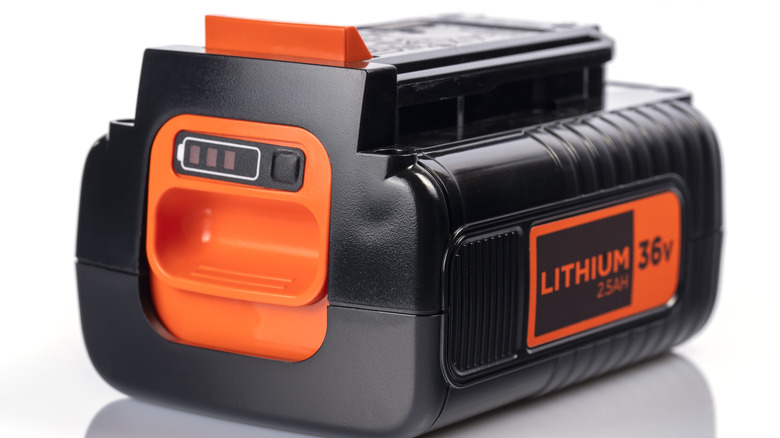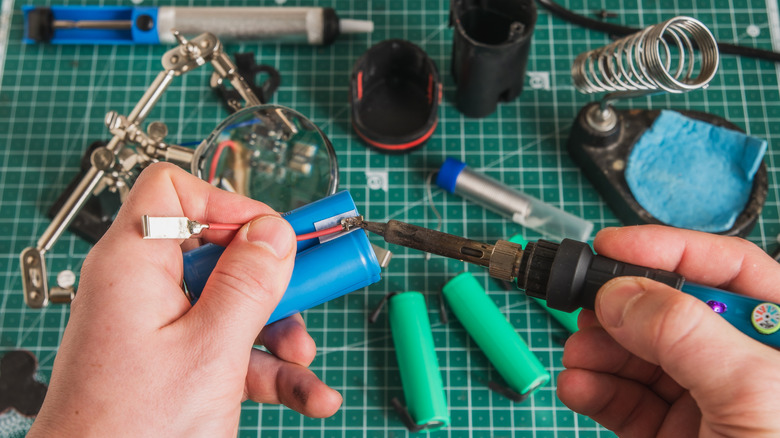Is Refurbishing Your Power Tool Batteries Dangerous? Here's What You Should Know
It's no secret that power tools have really come a long way. Not too long ago, almost every woodworking power tool (from grinders and routers to saws and planers) had to be plugged into the wall, limiting how and where you worked. Nowadays, almost every major power tool brand is shifting to run its tools through rechargeable batteries instead of plug-in cords. However, while this rechargeable system brings a lot of convenience, such as the freedom to work anywhere, it also comes with one big catch: lithium-ion batteries gradually diminish over time.
Generally, you should always expect lithium-ion power tool batteries to provide you with 300 to 500 charge cycles (or to last about two to three years). But after months of heavy use and engaging in everyday habits that can degrade your power tool battery — like overcharging and using the wrong charger for your tool — your trusty battery will start to lose charge. Even worse, it might overheat or stop working altogether.
When this happens, you'll probably think of refurbishing your power battery tool (whether by yourself or sending it to a third-party service). After all, why spend $100 on a brand-new pack when you can just open up your battery and swap the non-functioning cells with new ones? But as cost-effective as this might sound, it's best you think twice before replacing lithium-ion batteries at home. Furthermore, there are tons of legitimate reasons to avoid refurbishing lithium-ion batteries.
Reasons why lithium-ion battery refurbishment is risky
When you check out YouTube videos showcasing how to troubleshoot a lithium-ion battery, the DIY process might seem like a walk in the park. However, refurbishing is one of the common mistakes people make with Lithium-ion batteries (including those for consumer electronics), and you must be cautious; these batteries are far more complicated than that. The reason is that each pack features a liquid electrolyte, which is highly flammable. As such, if you make a single wrong move during disassembly or reassembly, the result will damage the battery and potentially cause a fire or explosion.
Aside from that risk, refurbishing a lithium-ion battery (especially an old or damaged battery) could also create thermal runaway. It's a technical term for when a battery cell enters an uncontrolled, self-heating state, often when the heat generated in the cell exceeds the heat dissipated. When this happens, the battery tends to experience an instant increase in temperature, which, in turn, could result in a fire or an explosion in the worst-case scenario.
There is also the matter of chemical hazards. If you decide to refurbish a lithium-ion battery, you'll probably come into contact with flammable and toxic vapors, such as hydrofluoric acid (in either gas or liquid form). Besides that, there's a risk of exposing yourself to corrosive solvents like ethylene carbonate, especially if you puncture these batteries. When this happens, you could end up with eye irritation and respiratory distress. That's why, if your battery dies or experiences functional issues, it's best that you consider purchasing a new one instead of rebuilding or refurbishing the old battery.
Safer alternatives to refurbishing a damaged power tool battery
If your power tool battery needs repair, rather than attempting to fix it, you might be tempted to seek a third-party for professional refurbishment. Of course, there are some companies that rebuild power tool batteries by replacing degraded cells with new ones. They'll also perform diagnostic checks to verify voltage, capacity, and balance. At a glance, this might seem like a safe bet compared to risky DIY attempts, but it's essential to approach third-party options with caution.
Actually, the quality of work can vary since not all refurbishers uphold the same quality standards and workmanship. Some unscrupulous refurbishers can hide the actual condition of the battery, while others may even offer difficult-to-spot fake power tool batteries. Hence, without transparency or certifications, there's no assurance that the replacement or assembly matches the reliability of original equipment manufacturer (OEM) standards.
A better and safer choice is to replace damaged batteries with manufacturer-approved replacements. This approach will not only improve your tool's performance but also maintain the quality of your work. After all, most woodworking projects designed for both beginners and professionals alike require precision and speed, which can be achieved with tools that are ready to perform as they should.


